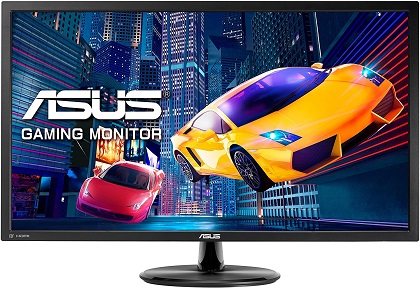These days many of us spent quite a lot of time in front of the computer screen. Many of us have jobs that are performed on a computer. Then we come home and do a lot of private stuff on a computer as well. Then we entertain ourselves by watching a movie or a TV show on a computer screen as well. All-in-all this adds up to a lot of screen time. That said, you can imagine that it is extremely important to ensure you are using the best computer monitor for eyes.
In this article, we will cover all ins and outs of the best computer monitor for eye models. We will start by explaining what causes eye strain in the first place. We will tell you why you should consider using a special monitor for computer eye strain, and present you with 12 best computer monitors for eye models, which will enable you to choose one that best suits your needs.
We will also provide you with the best computer monitor for eyes buyer’s guide and answer many common questions that will further provide you with understanding on the topic and help you ensure that your eyes are not taking too much of a hit due to prolonged screen time.
Are you ready to dig in? Let’s do this.
What causes eye strain?
Before we move one, we feel like you must understand the underlying issue. So what causes eye strain? In general, eye strain is a symptom, which occurs when your eyes get tired of intense use for a prolonged period of time. This is often due to long reading sessions or screen time.
If you have been staring at a screen for hours and felt that unpleasant feeling in your eyes, that was eye strain. Eye strain symptoms can be expressed in various ways. You may feel eye fatigue, headache, blurred vision, pain around eyes, or others.
Keep in mind that eye strain is not a permanent condition and that after you rest your eyes it normally goes away. However, if you are experiencing prolonged eye strain on a regular basis, you could develop more permanent eye issues, such as Computer Vision Syndrome (CVS).
Eye strain is one of the issues of CVS, which is something that around 50% of regular computer users experience.
As such, it makes a lot of sense to pay some extra attention to what kind of monitor we use and perhaps even consider investing in the best computer monitor for eyes. Though, keep in mind that computer monitor type is not the only aspect you need to consider. Things like your posture, screen position, lighting, and similar all play very important roles.
Why use a special monitor for computer eye strain?
Using the best computer monitor for eyes is essential for those who spend prolonged hours in front of it. That way you can prevent or cure CVS and eliminate or minimize eye strain. This will contribute to your overall wellbeing, your mood, your energy, productivity, and more.
It really makes sense to use the best computer monitor for eyes.
12 Best Monitor for Eyes Models
This is the section that many of you’ve been waiting for. Herein, we will take a closer look at 12 best computer monitors for eye models that all have the potential of being the best option for you. We did extended research to find the information which we share with you below.
ASUS PB278Q 27” WQHD 2560×1440 IPS HDMI DVI Eye Care
About the monitor for eyes and performance:
The PB278Q is produced by ASUS, which is a highly reputable brand. It is a very large 27-inch monitor and supports a native 2560 by 1440 resolution with a standard 16:9 aspect ratio. It is a flat LED monitor with an IPS panel type.
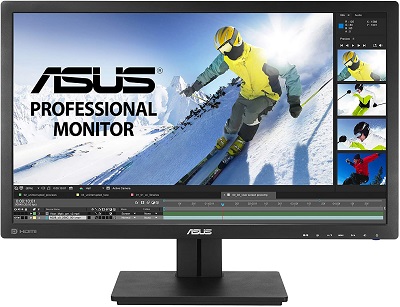
Key features:
- Ergonomic Design
- Wide View Angle
- Flicker-Free
- Size: 27-inch
- 16:9 ratio
- LED technology
- 2560 x 1440 resolution
- IPS panel type
- Speakers
 Ergonomic Design
Ergonomic Design Wide View Angle
Wide View Angle Flicker-Free
Flicker-Free
 Thick bezel
Thick bezel
ViewSonic VX2457-MHD 24 Inch Gaming Monitor with FreeSync Eye Care
About the monitor for eyes and performance:
The VX2457-MHD from ViewSonic is a big 24-inch eye care monitor with eye protection as the main priority during development. It natively supports up to 1920 x 1080 resolution with a 16:9 aspect ratio. It is a flat LCD monitor with a panel type of TN.
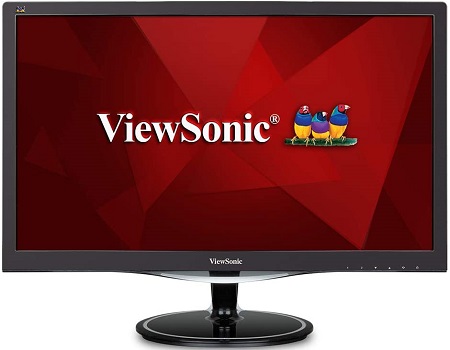
Key features:
- Flicker-Free
- Blue Light Filter
- FreeSync
- Size: 24-inch
- LCD technology
- 16:9 ratio
- 1920 x 1080 resolution
- TN panel type
- Speakers
 Flicker-Free
Flicker-Free Blue Light Filter
Blue Light Filter FreeSync
FreeSync
 Thick bezel
Thick bezel
BenQ GW2765HT Eye Care Home & Office Low Blue Light Technology
About the monitor for eyes and performance:
The GW2765HT is a 27-inch monitor from BenQ. It is designed for home and office work with eye care as a priority implemented during development. It offers a 2560 x 1440 resolution and the aspect ratio is 16:9. It is a flat LED monitor with a panel type of IPS.
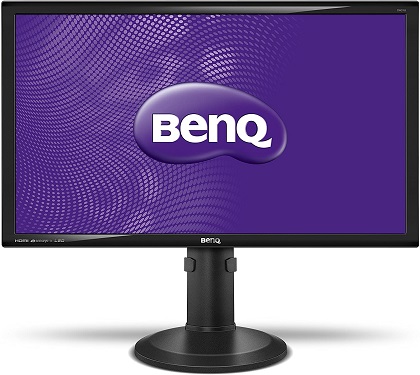
Key features:
- Low Blue Light
- ZeroFlicker
- High Resolution
- Size: 27-inch
- 16:9 ratio
- LED technology
- 2560 x 1440 resolution
- IPS panel type
- Speakers
 Low Blue Light
Low Blue Light ZeroFlicker
ZeroFlicker High Resolution
High Resolution
 Thick bezel
Thick bezel No sync capabilities
No sync capabilities
Asus VP28UQG 28” FreeSync Eye Care Monitor
About the monitor for eyes and performance:
The VP28UQG from ASUS has a display size of 28 inches and has a 3840 by 2160 resolution with a 16:9 aspect ratio. It is a 4k monitor created specifically with eye care in mind. It is a TN panel LED monitor.
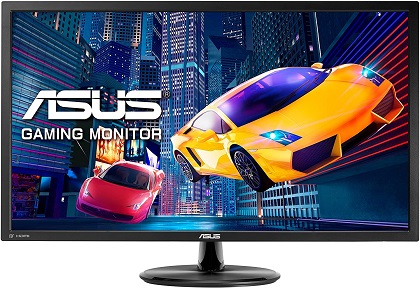
It packs a 1 millisecond response time is sufficient for any kind of use including professional-level gaming. The 60 Hz refresh rate is low but still sufficient for basically all tasks.
Key features:
- Reduced Blue Light
- Flicker-Free
- FreeSync
- High Resolution
- Size: 28-inch
- 16:9 ratio
- LED technology
- 3840 x 2160 (4k) resolution
- TN panel type
 Reduced Blue Light
Reduced Blue Light Flicker-Free
Flicker-Free FreeSync
FreeSync
 No speakers
No speakers Thick bezel
Thick bezel
Samsung U28E590D 28-Inch 4k UHD LED-Lit Monitor with Eye Saver Mode
About the monitor for eyes and performance:
The U28E590D is a 28-inch Samsung’s monitor. It supports 4k resolutions and offers a 16:9 aspect ratio. It is a flat LED monitor and has a TN panel type.

It delivers a not-impressive a refresh rate of 60 Hz and a stunning 1 millisecond response time. It comes with FreeSync compatibility. It packs all one needs to keep your eyes protected during extended use.
Key features:
- Eye Saver Mode
- High Resolution
- Size: 28-inch
- 16:9 ratio
- LED technology
- 3840 x 2160 (4k) resolution
- TN panel type
- Speakers
 Eye Saver Mode
Eye Saver Mode Good Console Gaming Specs
Good Console Gaming Specs FreeSync
FreeSync
 Thick Bezel
Thick Bezel
LG 32MA70HY-P 32-Inch Full HD with Reader Mode
About the monitor for eyes and performance:
The LG 32MA70HY-P is a huge screen and offers multiple windows to be displayed simultaneously. It is especially convenient for users that deal with great quantities of text – “Reader Mode”. It is a flat LED display and has an IPS panel type.
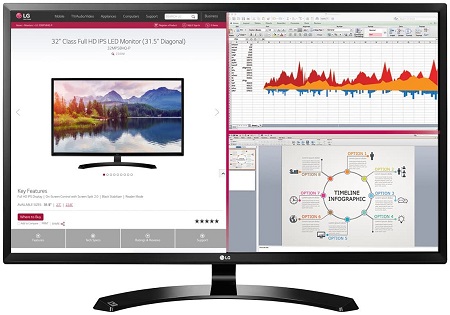
Key features:
- Low Blue Light Mode (Reader Mode)
- Large Screen Size
- VESA Compatible
- Size: 32-inch
- 16:9 ratio
- LED technology
- 1920 x 1080 resolution
- TN panel type
 Low Blue Light Mode (Reader Mode)
Low Blue Light Mode (Reader Mode) Large Screen Size
Large Screen Size VESA Compatible
VESA Compatible
 No speakers
No speakers Thick bezel
Thick bezel No sync capabilities
No sync capabilities
BenQ 24 Inch IPS Monitor Proprietary Eye-Care Tech
About the monitor for eyes and performance:
The BenQ 24 Inch IPS Monitor Proprietary Eye-Care Tech is a solid monitor. It offers an aspect ratio of 16:9 and a maximum resolution of 1920 x 1080. It is a flat LED screen with an IPS panel type.
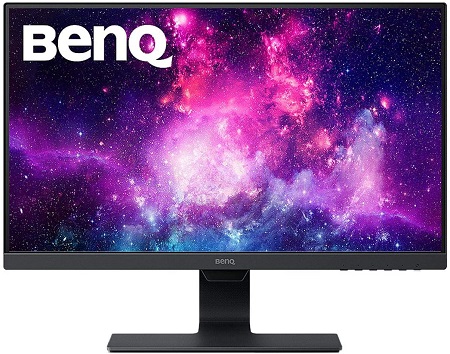
It incorporates a proprietary eye care technology that is designed to reduce blue light and flickering. The viewing angle is wide. It also has an automatic method for adjusting brightness, which contributes to more eye comfort and the least strain.
Key features:
- Thin Bezel
- Wide Viewing Angle
- Eye Care Mode- BenQ Eye Care
- VESA Compatible
- Size: 24-inch
- 16:9 ratio
- LCD technology
- 1920 x 1080 resolution
- IPS panel type
- Speakers
 Thin Bezel
Thin Bezel Wide Viewing Angle
Wide Viewing Angle Eye Care Mode
Eye Care Mode
 No sync capabilities
No sync capabilities
ViewSonic VA2855SMH
About the monitor for eyes and performance:
The ViewSonic VA2855SMH is specially made for home and office purposes. It offers a 1080 pixels high definition resolution. The monitor delivers the static contrast of 3,000:1.
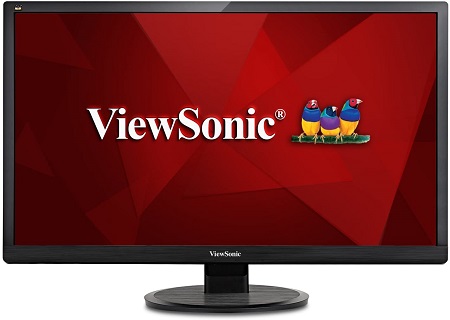
It also packs a flicker-free technology in order to reduce and prevent the eye strain of the user. It further offers a blue light filter technology, which serves to further protect the user’s eyes.
Key features:
- Flicker-free technology
- Blue light filter technology
- VESA Compatible
- Size: 28-inch
- 78:1 ratio
- LCD technology
- 1920 x 1080 resolution
- Built-in speakers
- 3 years warranty
 Blue light filter
Blue light filter Full high definition display
Full high definition display ViewSonic’sViewMode customizes each application’s experience
ViewSonic’sViewMode customizes each application’s experience Built-in speakers for clear sound
Built-in speakers for clear sound 8-bit color display
8-bit color display
 The display might become blurry.
The display might become blurry. The calibration settings of the monitor are a little difficult.
The calibration settings of the monitor are a little difficult.
ASUS ZenScreen MB16AC
About the monitor for eyes and performance:
The ASUS ZenScreen MB16AC is one of the best portable monitors for eyes. Its size makes it extremely portable and suitable for commuting and travel. It is 15.6-inch big. It is based on the IPS panel and uses LED technology. The display is free of flickers and can be converted into a touch screen with the use of USB Type-C cable. It can be used in portrait and landscape modes.

Key features:
- Blue light filter
- Flicker-free
- Fully compact – best for travel
- 6-inch
- LED Technology
- IPS panel type
- 1920 x 1080 pixels
- Touch screen through C-Type USB
- 16:9 aspect ratio
 Extremely lightweight
Extremely lightweight Portable monitor
Portable monitor Can be connected to many different devices
Can be connected to many different devices Compatible with Thunderbolt 3
Compatible with Thunderbolt 3 TUV Rhineland certified (eye protection)
TUV Rhineland certified (eye protection)
 No built-in speakers
No built-in speakers The product is very fragile
The product is very fragile
Asus Designo MX259HS
About the monitor for eyes and performance:
The Asus Designo MX259HS offers a screen size of 25 inches, with a full high definition resolution. It provides a wide viewing angle of 178°. It is ergonomically designed and thus great for multipurpose use.

It packs two stereo speakers. The screen is framed by a thin lining, which allows the monitor to be called frameless. The base of the screen has a metallic finish. This monitor has a TUV Rhineland certified eye care technology as well. The eye care technology uses a blue light filter, along with a flicker-free backlighting technique. The display of the screen is also anti-glare.
Key features:
- Flicker-free technology
- Blue light filter technology
- Size: 25-inch
- 16:9 ratio
- IPS panel type
- 1920 x 1080 resolution
- Built-in speakers
- 3 years warranty
 Versatile connectivity options
Versatile connectivity options High definition display
High definition display Easy connection settings
Easy connection settings Clear sound through built-in speakers
Clear sound through built-in speakers Eye care technology
Eye care technology
 The product is not very rugged
The product is not very rugged The customization settings of the display may lag
The customization settings of the display may lag
ViewSonic VX2476-SMHD
About the monitor for eyes and performance:
The ViewSonic VX2476-SMHD is another of the best monitor for eyes models. It offers a solid resolution of 1920 x 1080 pixels and a decent 24-inch widescreen size. It is a frameless LCD.

The screen uses the IPS panel type. It is completely free of flickers, which plays a vital role in protecting the eyes. It also comes with an impressive 3-year warranty.
Key features:
- Flicker-free technology
- Frameless design
- Size: 24-inch
- 16:9 ratio
- IPS panel type
- LCD technology
- 1920 x 1080 resolution
- Built-in speakers
- 3 years warranty
- VESA Compatibility
 High definition display
High definition display Built-in speakers for an amazing quality of sound
Built-in speakers for an amazing quality of sound Frameless, wide, and elegant design
Frameless, wide, and elegant design Versatile connectivity options
Versatile connectivity options Clear view from every vantage point
Clear view from every vantage point
 Difficult to adjust the screen’s settings
Difficult to adjust the screen’s settings Issues faced during VESA mounting
Issues faced during VESA mounting
BenQ GW2280 – Best Affordable Computer Screen For Eye Strain
About the monitor for eyes and performance:
The BenQ GW2280 is specifically targeted for office and home users. It packs the speakers, ultra-high 3000:1 native contrast, 20M:1 dynamic contrast ratio, and true 8-bit panel performance. The product also has a VA LED to refresh the view with fantastic colors and details.

The manufacturer has incorporated industry-leading Eye-Care technology to ensure user comfort during long hours of use.
Key features:
- Anti-glare
- Edge to edge slim bezel design
- Eye-Care technology
- Size: 21.5-inch
- 16:9 ratio
- IPS panel type
- LED technology
- 1920 x 1080 resolution
- Built-in speakers
 Very lightweight product – easy to transport
Very lightweight product – easy to transport Decent brightness levels and reduces monitor eye strain
Decent brightness levels and reduces monitor eye strain Easy choices to lessen blue light and turn on reading modes
Easy choices to lessen blue light and turn on reading modes The bezels are small and do not distract while working
The bezels are small and do not distract while working BenQ’s patented Brightness Intelligence Technology: the anti-glare computer screen self-adjusts the brightness and relieves eye strain
BenQ’s patented Brightness Intelligence Technology: the anti-glare computer screen self-adjusts the brightness and relieves eye strain
 Some users report that the quality of speakers is not great
Some users report that the quality of speakers is not great Some users complain that it is somewhat difficult to adjust the brightness
Some users complain that it is somewhat difficult to adjust the brightness
How do certain monitors help protect your eyes?
All monitors presented above help protect your eyes. You may be wondering how do they do that, right? Well, the trick is to incorporate eye-comforting technology. Now, each of the manufacturers and brands has their own trick and patents to achieve that, though the main goal is to eliminate flickering and to filter out as much of the blue light as possible. Those are the two main aspects that the best computer monitor for eyes must address.
Aside from that, it may also pack advanced auto-brightness adjustments, highly adjustable height and angle positioning options, wide viewing angle, and more. Some may also incorporate special reading mode, which makes them very much like kindle display (paper-like), which is more soothing on the eyes. This is especially important for users that do a lot of reading on a computer.
Think Before You Choose the Best Monitor for Your Eyes
It is important to devote some thought to your monitor purchase, especially if you want to get the best monitor for your eyes. Sure, the simplest way would be to select one of the 12 models presented in the section above, however, there are a lot of displays on the market and you may want to explore the options further on your own.
As such, we want to provide you with this best computer monitor for eyes buyer’s guide.
Monitor Size/Size of the Screen
Size does matter. However, considering that you sit about 70 cm from the screen, anything above 17 inches does the trick. However, if you are used to having multiple windows open simultaneously, you may want to get bigger displays. 24-inches or larger is great. That way you can have 2 or even 4 windows open at the same, which will enable you to get more things done faster. It also enables you to set larger fonts and lessen the strain on your eyes.
Contrast, Response Time and Viewing Angle
Contrast, response time, and viewing angle are three very important specifications that affect user experience and your eyes noticeably. It is important to make the proper use of the settings and adjust the contrast to best suit your environment.
If the contrast is too low or too high it can be stressful for your eyes to process the picture. Contrast is basically the span between the light and dark spots.
The response time determines how long it takes for the monitor to understand and display inputs. This is most often observed in the mouse movement. If the response rate is too low, it can cause problems since there will be a constant delay between what you are doing and what you are seeing.
Viewing angle is important if you use a display in various positions. If you are only using it sitting at the desk, where you can perfectly adjust the position, then it may not play such an important role.
Refresh Rate
Monitor refresh rate tells you how often your monitor “refreshes” the image on the screen. A 60 Hz refresh rate is the most common option these days, which means that the screen is refreshed 60 times per second. The higher the refresh rate, the lower the chances of flickering to occur, and the more soothing the viewing experience. However, the 60Hz is ok as far as the eyes are concerned.
Eye care technology
If you are looking for the best computer monitor for eyes, then you definitely want to devote some extra attention to this section. The primary concern that has a high negative effect on your eyes and your brain is the blue light. There has been a lot of progress in that aspect and much useful software and hardware adjustments have been made to filter out a great portion of the blue light. Your best computer monitor for eyes should absolutely have blue light-filtering functions.
Flickering is the second thing you do not want in your monitor if you are to protect your eyes. If your eyes are able to detect the moving light of the monitor, this can have a negative effect on your vision.
Anti-glare is a third important aspect of the eye care aspect.
The best computer monitor for eyes should pack all these features.
Resolution of the Display
At this age, anything below 1080p (1920 x 1080) should not be considered. However, if you plan on working with 4k media, you want to get a 4k monitor.
If the resolution is too low, the images get blurry, which causes eye strain.
Aspect Ratio
16:9 is more or less a standard here and there are not many alternatives. This ration has proven to be the optimal one for various tasks. However, if you are a pro gamer or video editor, you may want to explore other more rare prolonged monitors.
Connectivity Options
HDMI is the most common connectivity option used these days. However, VGA is still often used. In addition, you need to check if USB connectivity is available if that is something you are interested in. Before the purchase, double-check that all the connectivity options that interest you are available.
Blue Light Filter
We have covered blue light in the ‘Eye care technology’ section, however, we want to point out that some displays may have advanced physical filters built into the outer layers of the screen. This can be extremely efficient in blocking harmful blue light rays.
Glare
Strong light glare in your display can be extremely annoying and also harmful for your eyes. As such, it is important to eliminate glare. Many best computer monitors for eyes incorporate antiglare features.
Ergonomics
The ergonomics of a monitor are very important as it what ensures comfortable use. The monitors must be adjustable in a way that you can customize the position and angle. That way you set things up for maximum convenience.
Manufacturer Warranty
Many monitors come with long manufacturer warranties. A 3-year warranty is not uncommon. As such, it makes sense to consider that aspect as well.
Design and Construction
Design and construction won’t have much impact if any on your eyes, however, you do not want to buy a display that you find ugly. So make sure to account for your taste.
Moreover, a thick bezel can be annoying and make the viewing experience less pleasant.
How to Relief Computer Eyes Strain
There are many tricks and remedies that you can try to relieve computer eye strain. Some are free and can be applied with maximum ease, others require some habits to be changed, and some are rather costly.
Visit an Eye Doctor
If you are experiencing regular eye strain, you should make an appointment with an eye doctor to determine the cause. You may have dry eyes syndrome, CVS, or any other issue. It is important to get to the bottom of it ASAP.
Proper lighting
It is important to use proper lighting when using a computer. The worst thing you can do is to work in complete darkness with only screen light shining into your eyes. Strong sunlight could also be an issue. Always shut the drapes and ensure the windows are to your side.
The ambient light when using a computer monitor should be soft. Floor, corner, or gentle backlight are good options. “Full-spectrum” fluorescent lighting is also a good choice, however, make sure it is not too bright.
20-20-20 Rule
The 20-20-20 rule has proven to be one of the most efficient ways to combat eye strain. It is very simple: every 20 minutes, look at something 20 feet away for 20 seconds.
Proper posture
This is extremely important. This requires a proper display position, a proper chair, and a proper setting position. You want your top monitor’s frame to be in line with your eyes, your spine to be long and tall, your feet to be flat on the floor, and 90° angles to be established at elbows, hips, and knees.
Eliminate or minimize glare
Do whatever you can to minimize glare. Choose the best angle and use shading to avoid glare.
Getting the Best Computer Monitor for Eyes
Getting a new monitor, is definitely not the most inexpensive solution. However, if you are already considering buying a new display, it won’t cost much more to go with the best computer monitor for eyes. This remedy is extremely effective and offers a permanent solution.
Adjust your monitor settings
The most important settings include brightness, text size, contrast, and color temperature. Also, make sure that you have an eye-comfort option turned on (if available).
Blink more often
When you blink you lubricate your eyes. And when we stare at the screen we tend to blink less often. As such, intentionally increasing the frequency of our blinking can have a soothing effect on our eyes.
Take short brakes often
Aside from 20-20-20 rule aim to take short brakes every hour and one or two longer (10 -15 min) brakes every two or three hours.
Consider computer glasses
This are special glasses designed to block all or most of the blue light away. If you can’t afford the best computer monitor for eyes, you can get those glasses. They are normally very affordable.
Best Monitor Settings for Eyes
Brightness, contrast, text size, and color temperature are the most important setting. As such, we will focus on those.
- Brightness: Aim to adjust the brightness of the display so it’s approximately the same as the brightness of your surrounding workstation. As a test use a piece of white paper and white background of your text software. If the display looks like a light source, it’s too bright. If it seems dull and gray, it may be too dark.
- Text size and contrast: This is extremely important when you do a lot of reading on your computer. Adjust the text size and contrast to achieve maximum comfort. Typically, black print on a white background is the best combination for eyes comfort.
- Color temperature: Blue light is short-wavelength visible light that is associated with more eye strain than longer wavelength hues (red and orange shades). Setting your display to warmer colors (increasing the color temperature) lowers the amount of blue light emitted and can provide you with a much better long-term viewing comfort.
Is an LCD or LED monitor better for your eyes?
We got rid of cathode displays (CRT) quite some time ago. LCD and LED technology are the two most common and most advanced options these days.
Herein, we will cover the cons and pros of each of those types of best computer monitors for the eyes.
At this point it has not been proven that either LCD or LED can be generally classified as better for the eyes, though, some claim that the cold cathode technology used in LCD monitors causes eye strain. If we also consider the fact that LED displays are more energy-efficient and conservative, they may be the better choice overall.
LCD Pros & Cons
+ LCD monitors are usually the more affordable option
+ LCD screens are available in a wide range of sizes and take up very little space on your desk.
+ The screen can also be easily viewed at a variety of angles and they work well in both bright and low light conditions.
+ LCD technology offers 120 Hz displays.
– LCDs use more energy.
– LCD work based on the cold cathode.
LED Pros & Cons
+ LED doesn’t use the type of fluorescent cold cathode technology
+ LED screens to use light diodes to illuminate the screen
+ LEDs with dimming option are the best choice
+ LED monitors offer top of the line clarity and color quality
+ LED monitors offer better than average energy saving abilities compared to LCD monitors
+ Their local dimming option allows the user to fine-tune the screen’s settings
– Viewing angles are still limited compared to LCD monitors
– They are normally pricier than LCDs
FAQs
How do certain monitors help protect your eyes?
If monitors incorporate eye comfort technology that eliminates flickering, blue light, and glare it helps your eyes and prevents eye strain.
Why does your vision change with age?
As most people age, they lose the flexibility of their lens. This results in an inability to adjust focus properly for near objects.
Can staring at monitor damage your eyes?
Yes. Staring at monitors can cause eye strain. However, eye strain does not mean long term consequences. However, it can lead to prolonged or chronic eye strain which can have long term consequences and can compromise your sight. The entire brightness (of your monitor and surrounding light) should be rather low – it should match the natural surroundings.
Is a bigger computer screen better for eyes?
To a certain point yes. A bigger display enables you to view larger fonts.
How do you relieve eye strain?
Resting your eyes is the best method. 20-20-20 rule (presented above) is also a great way.
What is the best background color to reduce eye strain?
When it comes to monitoring background color (for reading), white or slightly yellowish is the best option. If you want to add ambient light, the one that mimics displayed colors works best. If that is not possible, use warm, soft colors.
What treatment options are best for computer eye strain?
Blinking more often and taking more rests are the two treatments everyone can safely apply. Others require a visit to your eye doctor to determine the exact condition of your eyes.
Does blue light affect sleeping patterns?
Yes. It has been scientifically proven that blue light disrupts your sleep. As such, it is best to avoid using screens for at least one hour before you go to sleep.
Which computer screen brands are most reputable?
Acer, Dell, Asus, AOC, BenQ, HP, Samsung, LG, ViewSonic are some of the most reputable brands. Not all of them are focused on producing the best computer monitor for eyes.
You can read also about Computer Reading Glasses for Reducing Eye Strain

